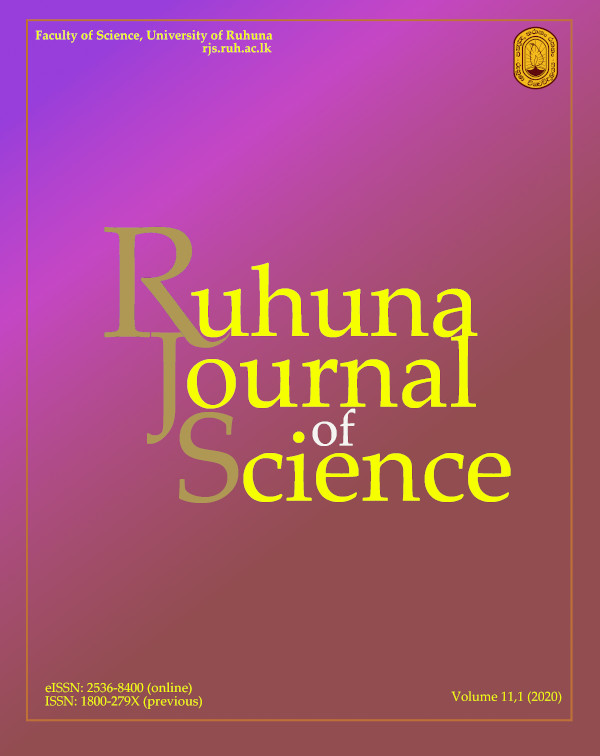Popularity and usage of different skincare agents among the inhabitants of Galle district in Southern province, Sri Lanka
Abstract
Cosmetics could be considered as one of the essential commodities in modern society, and the use of skincare agents has become a common practice in both men and women in Sri Lanka. Therefore, the present study was conducted to determine the popularity and usage of skincare agents among inhabitants in Galle district, Sri Lanka, and to assess the knowledge, attitudes, and awareness on the use of those products. Further, the attempts were made to identify widely used home-made natural skincare preparations for future pharmacological, clinical, and phytochemical evaluations. Thus, 390 participants were recruited to the study by random sampling method and semi-structured, and open-ended interviews were conducted using a pre-validated questionnaire. Total number of users of skincare products were found to be 207 (53.1%). Skincare products were highly popular among females while unmarried people and the people of the age group 18-30 years were reported to be regular users. Although the usage of synthetic skincare products was more prevalent than herbal preparations, the knowledge on different parameters of the synthetic products was not satisfactory as only 100 (48.3%), 48 (23.2%) and 82 (39.6%) individuals among the regular users were aware of pH, sun protection factor (SPF) and chemical composition of those products respectively. Interestingly, most of the participants believe in the safety and non-toxic features of natural herbal formulations, thus, it reflects the urgent need of exploring Sri Lankan flora for the development of herbal cosmetics. Keywords: Herbal preparations, skincare agents, synthetic cosmeticsReferences
Ahmad M, Khan MA, Zafar M. 2008. Traditional herbal cosmetics used by local women communities in district Attock of Northern Pakistan. Indian Journal of Traditional Knowledge 7(3): 421-424.
Department of Census and Statistics. 2017. http://www.statistics.gov.lk/pophousat/cph2011/Pages/ Activities / Reports/ Southern.pdf. Accessed 25th June 2017
Gediya SK, Mistry RB, Patel UK, Blessy M, Jain HN. 2011. Herbal Plants: Used as a cosmetics. Journal of Natural Product and Plant Resources 1: 24-32.
Gunapala AAS, Kumara NWD. 2015. Ayurveda for beauty cultural purpose- a review. Proceedings of 3rd International Conference on Ayurveda, Unani, Siddha and Traditional Medicine 188.
Hamed, SH, Tayyem R, Nimer N, AlKhatib HS. 2010. Skin-lightening practice among women living in Jordan: prevalence, determinants, and user's awareness. International Journal of Dermatology 49(4): 414-420.
Jayaweera DMA. 1982. Medicinal plants (Indigenous and exotic) used in Ceylon, Part 1-5. National Science Council, Sri Lanka.
Mahé A, Blanc L, Halna JM, Kéita S, Sanogo T, Bobin P. 1993. An epidemiologic survey on the cosmetic use of bleaching agents by the women of Bamako (Mali). Annales De Dermatologie Et De Venereologie 120(12): 870-873.
Nirmalan TE. 2017. Cosmetic Perspectives of Ethno-botany in Northern Part of Sri Lanka. Journal of Cosmetology & Trichology 3:126.
Rusmadi SZ, Ismail SNS, Praveena SM. 2015. Preliminary study on the skin lightening practice and health symptoms among female students in Malaysia. Journal of Environmental and Public Health vol. 2015, Article ID 591790: 6 pages.
Rekha MB, Gokila K. 2015. A study on consumer awareness, attitude and preference towards herbal cosmetic products with special reference to Coimbatore city. International Journal of Interdisciplinary and Multidisciplinary Studies 2(4): 96-100.
Ribeiro AS, Estanqueiro M, Oliveira MB, Lobo JMS. 2001. Main benefits and applicability of plant extracts in skincare products. Cosmetics 2(2): 48-65.
Wijesundera DSA. 2004. Inventory, documentation and medicinal plant research in Sri Lanka. Medicinal Plant Research in Asia 1: 184-195.
Downloads
Published
Issue
Section
License
From Volume 7 (2016) onwards, all articles published in Ruhuna Journal of Science are Open Access articles published under the Creative Commons CC BY-NC 4.0 International License. This License permits use, distribution and reproduction in any medium, provided the original work is properly cited and is not used for commercial purposes.
Copyright on any research article published in RJS is retained by the respective author(s).
Authors who publish with this journal agree to the following terms:
a) Authors retain copyright and grant the journal right of first publication with the work simultaneously licensed under a Creative Commons Attribution License CC-BY-NC 4.0 International, that allows others to share the work with an acknowledgement of the work's authorship and initial publication in this journal.
b) Authors are able to enter into separate, additional contractual arrangements for the non-exclusive distribution of the journal's published version of the work (e.g., post it to an institutional repository or publish it in a book), with an acknowledgement of its initial publication in this journal.
c) Authors are permitted and encouraged to post their work online (e.g., in institutional repositories or on their website) prior to and during the submission process, as it can lead to productive exchanges, as well as earlier and greater citation of published work (See The Effect of Open Access).

